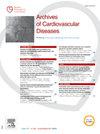Evaluation of left atrial characteristics and its impact on Prognosis in ESUS Patients: Insights from a cohort of AIS patients treated with mechanical thrombectomy or thrombolysis
IF 2.2
3区 医学
Q2 CARDIAC & CARDIOVASCULAR SYSTEMS
引用次数: 0
Abstract
Background
Embolic strokes of undetermined source (ESUS) represent 1/6 ischemic stroke (IS) and have high recurrence rate. Their physiopathology is not fully understood. Studying ESUS patients and their left atrial (LA) characteristics may lead to more specific management strategies.
Objectives
To compare characteristics and prognosis of ESUS patients to those with atrial fibrillation (AF) and non-atrial causes, and to identify factors associated with MACE.
Methods
This study included patients with IS who underwent thrombectomy or thrombolysis and were followed for 1 year. Patients were classified by stroke etiology. The ESUS group was compared to AF (permanent and non-permanent) and a non-atrial causes group. Factors associated with MACE (overall mortality, stroke recurrence, and hospitalization for heart failure) were analyzed.
Results
The study included 337 patients: 64 with permanent and 84 with non-permanent AF, 106 with non-atrial causes, and 83 with ESUS. ESUS patients were older than the non-atrial group but younger than the AF groups. No difference was found in ECG LA myopathy criteria. Echocardiographic parameters showed the ESUS group was closer to the non-atrial group, with less LA remodeling, and significantly lower minimal and maximal indexed LA volumes and better strains in the three components than the AF groups. Reservoir strain in ESUS patients had a heterogeneous distribution (Fig. 1). The ESUS group had the worst prognosis. Factors associated with MACE were age, stroke history, peripheral artery disease, high blood pressure, inter-atrial blocks, and LV ejection fraction. LA strain tended to be associated with MACE.
Conclusion
In our cohort, the ESUS group presented less LA remodeling and dysfunction than the AF groups and were more similar to the non-atrial causes group. This could explain the lack of benefit from systematic anticoagulation treatments reported in ESUS groups. Further research is needed to better characterize this heterogeneous group.
ESUS患者左心房特征评估及其对预后的影响:来自机械取栓或溶栓治疗的AIS患者队列的见解
来源不明的栓塞性卒中(ESUS)占缺血性卒中(IS)的1/6,复发率高。其生理病理机制尚不完全清楚。研究ESUS患者及其左心房(LA)特征可能会带来更具体的治疗策略。目的比较ESUS患者与房颤(AF)和非心房原因患者的特点和预后,并确定与MACE相关的因素。方法本研究纳入行取栓或溶栓术的IS患者,随访1年。根据脑卒中病因对患者进行分类。ESUS组与AF(永久性和非永久性)和非心房原因组进行比较。分析与MACE相关的因素(总死亡率、卒中复发和心力衰竭住院)。结果该研究纳入337例患者:64例永久性房颤,84例非永久性房颤,106例非心房原因房颤,83例esu房颤。ESUS患者年龄大于非房颤组,但小于房颤组。心电图LA肌病标准无差异。超声心动图参数显示,ESUS组更接近非心房组,LA重构较少,最小和最大指数LA容积明显低于AF组,三组分应变均优于AF组。ESUS患者的水库菌株分布不均匀(图1)。ESUS组预后最差。与MACE相关的因素有年龄、卒中史、外周动脉疾病、高血压、房间传导阻滞和左室射血分数。LA菌株倾向于与MACE相关。结论在我们的队列中,ESUS组比AF组出现更少的LA重构和功能障碍,与非心房原因组更相似。这可以解释ESUS组缺乏系统抗凝治疗的益处。需要进一步的研究来更好地表征这一异质群体。
本文章由计算机程序翻译,如有差异,请以英文原文为准。
求助全文
约1分钟内获得全文
求助全文
来源期刊

Archives of Cardiovascular Diseases
医学-心血管系统
CiteScore
4.40
自引率
6.70%
发文量
87
审稿时长
34 days
期刊介绍:
The Journal publishes original peer-reviewed clinical and research articles, epidemiological studies, new methodological clinical approaches, review articles and editorials. Topics covered include coronary artery and valve diseases, interventional and pediatric cardiology, cardiovascular surgery, cardiomyopathy and heart failure, arrhythmias and stimulation, cardiovascular imaging, vascular medicine and hypertension, epidemiology and risk factors, and large multicenter studies. Archives of Cardiovascular Diseases also publishes abstracts of papers presented at the annual sessions of the Journées Européennes de la Société Française de Cardiologie and the guidelines edited by the French Society of Cardiology.
 求助内容:
求助内容: 应助结果提醒方式:
应助结果提醒方式:


